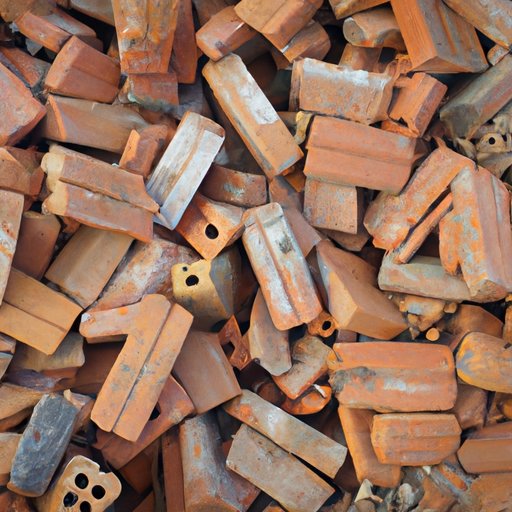
I. Introduction
When working on construction or renovation projects involving brick, the task of freeing bricks from cement and mortar can be a daunting one. However, salvaging old bricks instead of disposing of them can reduce waste and environmental impact, making it well worth the effort. In this article, we’ll explore techniques, tools, and creative repurposing ideas for old bricks.
II. 5 Simple Techniques to Free Bricks from Cement and Mortar
If you’re looking for a DIY approach to remove cement and mortar from bricks, there are several simple techniques you can try:
- Manual chiseling: Use a hammer and chisel to scrape away cement and mortar from the brick surfaces.
- Wire brush: Use a stiff-bristled wire brush to scrape away dried cement and mortar.
- Muriatic acid: Dilute muriatic acid according to the manufacturer’s instructions and apply it to the cement and mortar to dissolve it.
- Pressure washer: Use a pressure washer to blast away cement and mortar.
- Dry ice blasting: Use dry ice to blast away cement and mortar without damaging the brick surface.
Before you try any of these techniques, be sure to wear protective gear such as safety goggles and gloves. It’s also important to test the technique on a small area first to avoid damaging the bricks.
III. Sustainable Masonry: Reusing Old Bricks for New Builds
Reusing old bricks in new construction projects not only reduces waste but can also add character and history to the new structure. Here are some tips for safely freeing bricks from their previous structures:
- Use a hammer and chisel to carefully remove the old mortar from the brick.
- Soak the bricks in water for at least 24 hours to remove any remaining mortar.
- Inspect the bricks for damage or cracks before using them in new construction.
- Place the bricks in a dry, well-ventilated area to dry for several days before use.
Examples of construction projects that have reused old bricks include the High Line in New York City, which used reclaimed bricks from the elevated railway’s original construction in the early 1900s. The Brooklyn Navy Yard, a 300-acre industrial park, also used reclaimed bricks in its historic renovation.
IV. Breaking Free: Innovative Tools for Removing Cement from Bricks
If you’re a contractor or serious DIY enthusiast, there are some innovative tools and technology available for freeing bricks from cement and mortar. Here are some product reviews and recommendations:
- Bosh Bulldog Xtreme Rotary Hammer: This tool is perfect for chiseling away cement and mortar from bricks without damaging them.
- Hammer drill and chisel bit: A hammer drill with a chisel bit can be used to carefully remove cement and mortar from the brick surface.
- Pressure washer with a rotating nozzle: This tool can make quick work of removing cement and mortar from bricks.
- Pneumatic chisel: This tool is perfect for removing cement and mortar from large areas of brick surfaces.
As with the DIY techniques, it’s important to wear protective gear and test the tool on a small area first to avoid damaging the bricks.
V. From Ruins to Renewal: The Art of Salvaging Bricks
Reclaimed bricks can add a unique and artistic element to architecture and design. Here are some innovative ways to incorporate reclaimed bricks into your next project:
- Accent walls: Use reclaimed bricks to create an accent wall in a living room or office space.
- Patio or pathway: Use reclaimed bricks to create a patio or pathway in your yard.
- Fireplace surround: Use reclaimed bricks to create a stunning fireplace surround.
- Outdoor kitchen: Use reclaimed bricks to create an outdoor kitchen or BBQ area.
Preserving historical buildings is also a valuable use of salvaged bricks. For example, the famous Roman Colosseum was built using bricks taken from other buildings. The New York Public Library’s iconic lion sculptures are made from salvaged marble and stone.
VI. The Dos and Don’ts of Freeing Bricks
Whether you’re using a DIY technique or a professional tool, here are some practical tips for safely removing cement and mortar from bricks:
- Do wear protective gear such as safety goggles and gloves.
- Do test the technique or tool on a small area first to avoid damaging the bricks.
- Do soak the bricks in water for at least 24 hours to remove any remaining mortar.
- Don’t use acid to remove cement and mortar without diluting it according to the manufacturer’s instructions.
- Don’t use excessive force when chiseling away cement and mortar, as this can damage the bricks.
VII. Solving the Brick Puzzle: Creative Solutions for Repurposing Free Bricks
If you have a surplus of reclaimed bricks, try incorporating them into some creative and unique DIY projects:
- Garden planter: Stack reclaimed bricks to create a garden planter or raised garden bed.
- Bench or table: Use reclaimed bricks to create a rustic outdoor bench or table.
- Bookshelf: Stack reclaimed bricks to create a bookshelf or display stand.
- Candle or wine bottle holder: Use reclaimed bricks as a base for a candle or wine bottle holder.
Remember to handle the bricks with care to avoid damaging their unique shapes and patterns.
VIII. Conclusion
By reusing old bricks instead of disposing of them, we can reduce waste and environmental impact while adding character and history to new construction projects. Whether you’re a DIY enthusiast or a contractor, there are a variety of techniques and tools available for freeing bricks from cement and mortar. And if you have a surplus of reclaimed bricks, get creative and repurpose them into some unique DIY projects.





